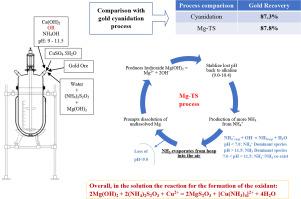Hydrometallurgy ( IF 4.7 ) Pub Date : 2022-07-29 , DOI: 10.1016/j.hydromet.2022.105943 Uchitta Vashist , Farzaneh Sadri , Yeonuk Choi , Ahmad Ghahreman

|
Thiosulfate gold leaching is an alternative gold leaching method, especially for leaching of preg-robbing gold ores. Here we report a thiosulfate process that has been developed for gold leaching, with emphasis on lowering thiosulfate consumption in the process. Ammonium thiosulfate has been used as the primary lixiviant along with magnesium hydroxide to saturate the solution with magnesium in the presence of copper(II) as an oxidizing agent. The resulting magnesium thiosulfate solution (Mg-TS) can potentially leach gold from the ore at considerably high efficiency. The potential for substantial decrease in the thiosulfate consumption, while achieving high gold recovery, gives the Mg-TS process a cutting-edge advantage over other processes. The study demonstrates the effect of pH, magnesium, and initial Cu(II) concentration on gold leaching kinetics in the Mg-TS process. As a comparison, pH of the tests was controlled with Ca(OH)2 and NH4OH; it was concluded that high pH, if controlled by NH4OH, is beneficial for gold leaching due to increase in ligand (NH3) availability and favorable pH range. Increasing pH using Ca(OH)2 was only effective up to a pH threshold of 9.8, after which the efficiency of the process decreases due to the precipitation of Cu(II) catalyst/oxidant. Increasing copper(II) concentration to 8 mM leached 87.8% of gold which was very close to the gold recovery with cyanidation (87.3%). The Mg-TS process identified is an operationally green and sustainable, efficient and low-cost thiosulfate process, which is feasible for in-situ/heap leaching of low-grade gold ores and is believed to present a competitive advantage over cyanidation process.
中文翻译:

饱和硫代硫酸镁浸金工艺关键参数系统研究 A 部分:氨和石灰对镁和铜 (II) 的 pH 值调节和浓度的影响
硫代硫酸盐浸金是一种可供选择的金浸出方法,特别适用于预浸金矿石的浸出。在这里,我们报告了一种已开发用于金浸出的硫代硫酸盐工艺,重点是降低该工艺中的硫代硫酸盐消耗。硫代硫酸铵与氢氧化镁一起用作主要浸出剂,以在铜 (II) 作为氧化剂存在的情况下用镁饱和溶液。由此产生的硫代硫酸镁溶液 (Mg-TS) 可能以相当高的效率从矿石中浸出黄金。在实现高金回收率的同时,硫代硫酸盐消耗量大幅减少的潜力使 Mg-TS 工艺比其他工艺具有尖端优势。该研究证明了 pH 值、镁、和初始 Cu(II) 浓度对 Mg-TS 过程中金浸出动力学的影响。作为比较,测试的 pH 值由 Ca(OH)2和NH 4 OH;得出的结论是,如果通过 NH 4 OH 控制高 pH 值,由于配体 (NH 3 ) 可用性的增加和有利的 pH 值范围,有利于金的浸出。使用 Ca(OH) 2提高 pH 值仅在 9.8 的 pH 阈值下有效,之后由于 Cu(II) 催化剂/氧化剂的沉淀,该过程的效率降低。将铜 (II) 浓度增加到 8 mM 会浸出 87.8% 的金,这与氰化处理的金回收率 (87.3%) 非常接近。所确定的 Mg-TS 工艺是一种绿色、可持续、高效和低成本的硫代硫酸盐工艺,可用于低品位金矿石的原位/堆浸,并且被认为比氰化工艺具有竞争优势。



























 京公网安备 11010802027423号
京公网安备 11010802027423号